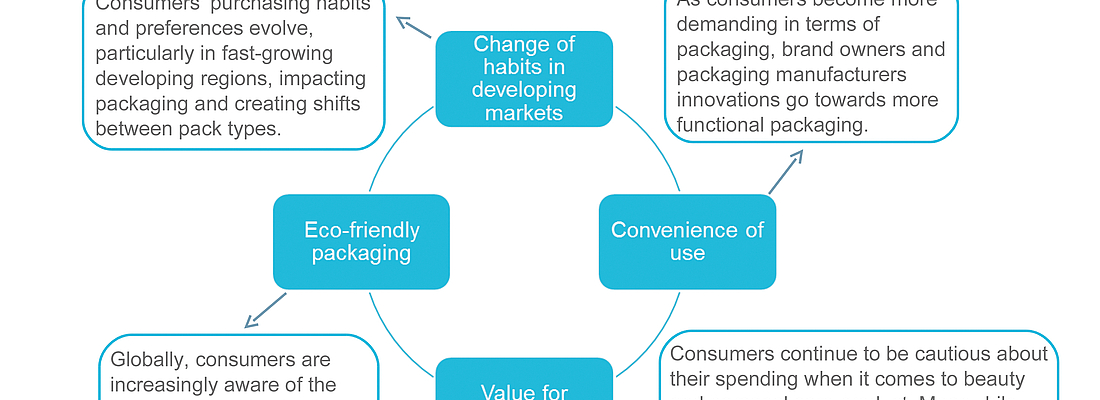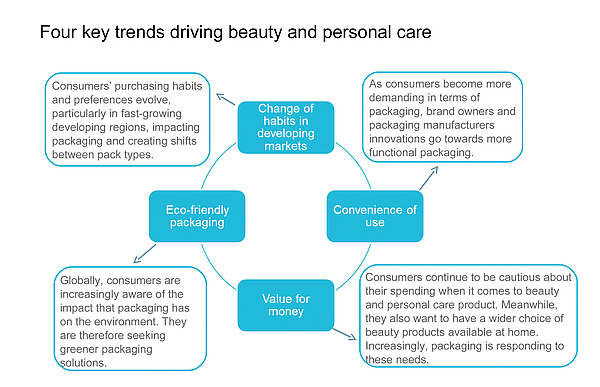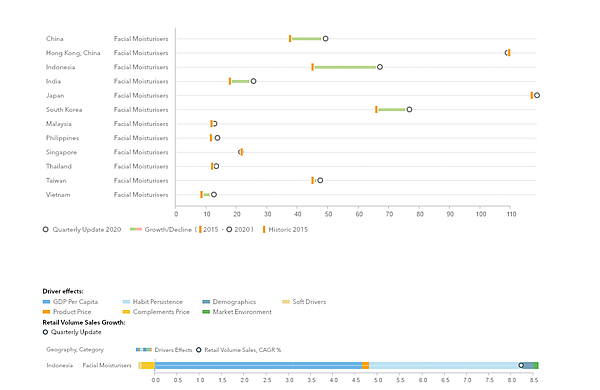

Beauty and personal care packaging showed good volume growth over 2011-2016, rising at a 3% CAGR to exceed 146 billion units in 2016. While developed regions slowed down global growth during this period, stronger expansion remains in developing regions, particularly in Asia Pacific, where larger gains in absolute growth terms are found in oral care, hair care and skin care packaging.

Within beauty and personal care, toiletries remain the largest generator of packaging volumes, led by bath and shower, hair care and oral care. While the main pack types for these applications, rigid plastic and flexible packaging, largely dominate beauty packaging, baby and child-specific as well as premium beauty products also offer strong prospects for growth.
TREND1
Growth opportunities in developing regions thanks to changing habits
In developing countries, demographic factors such as rising disposable income or urbanisation as well as change in legislation are impacting product consumption and therefore packaging, with consumers slowly moving away from single-use flexible plastic and increasingly adopting HDPE bottles and squeezable plastic tubes.
In Indonesia, hygiene routines are evolving resulting in consumers increasingly adopting facial moisturisers as part of their beauty regime. This is particularly the case in Asia Pacific for which Euromonitor’s forecast model highlights strong market potential in Indonesia, China, South Korea and India, when looking at facial moisturisers volume consumption per capita. While in South Korea, demand for skin care products is growing thanks to the importance of beauty for both male and female consumers and the multi-step skin care routines they follow daily, Indonesia, China and India offer best prospects thanks to their large populations which benefit from increasing disposable incomes. The increased adoption of skin care products in Indonesia is expected to benefit volume sales of squeezable plastic tubes forecast to grow at a 9% CAGR over 2015-2020.
The change in consumers’ hygiene routines in developing countries is also reflected in their increased adoption of shower gel over more traditional bar soap resulting in the shift from flexible paper and folding cartons (soap’s main packaging types) towards HDPE bottles.
The change in consumers’ hygiene routines in developing countries is also reflected in their increased adoption of shower gel over more traditional bar soap resulting in the shift from flexible paper and folding cartons (soap’s main packaging types) towards HDPE bottles.
TREND 2
More functional packaging in developing countries
Consumers being more nomadic, brand owners have to respond to their needs offering beauty products with pack sizes that fit their bags or airport security but also products that offer ease of dispensing (such as lotion pumps and aerosols) and that can be applied on the go.
Increasingly, consumers expect more from packaging and from its original role of protecting the product and transporting its content. While this phenomenon is present globally, it is particularly emphasised in saturated developed markets, where the demand for more sophisticated packaging with added value is stronger. An example of this is Gillette Fusion Pro-Glide 2-in-1 Shave Gel by Procter & Gamble, launched in 2015. The shaving gel, which comes in a PET container, presents a see-through window level indicator as well as a twist-lock system for more practicality. Gillette Fusion Pro-Glide’s retail price is higher than standard shaving gels, however as it targets male consumers, the price factor tends not to be as influential as for female consumers.
Brands are also launching smaller travel pack sizes for their products to respond to these trends, such as Bioderma Sensibio facial cleanser originally in 250ml PET bottle was additionally launched in a more portable 100ml bottle. Looking at on-the-go applications, Givenchy launched its Cushion Kiss which comes in a 10ml squeezable plastic tube by Albéa, with a cushion applicator to allow quick and easy touch ups on the go.

Retail Volume Sales ML Per Capita, 2015 - 2020 |
TREND 3
Value continue to be a key purchasing criteria, varied sizing supports
Globally, consumers continue to choose smaller pack sizes for immediate affordability in essential toiletries but also in discretionary products such as premium fragrances. Family sizes and alternative pack types such as pouches offer value too.
Single-use shampoos in flexible plastic continue to be a popular format in Asia Pacific, especially in India and Indonesia, where consumers are more price sensitive. Representing 6.3 billion units globally, 5ml is the most popular pack size, thanks to large unit volume sales in India and Indonesia, where this format is offered by many shampoo brands, including international players such as L’Oréal, Dove and TRESemmé. And while this pack type contributes to the affordability of shampoos for lower-income households usually in rural and semi-urban areas, it also fits these developing countries’ independent retail sector. In India, the average selling space for independent small grocers is at 36 sq m, while in Indonesia, traditional kiosks are 8 sq m, which leave little space for products on shelves.
Other strategies towards value for money include smaller sizes in premium fragrances, with the increasingly popular 10ml “travel size” format which also appealing to those who like to have a “wardrobe” of fragrances while maintaining their budget. Better value for money can also derive from larger pack sizes. Looking at shampoo in Western Europe, there is a clear shift towards larger and more economical rigid plastic bottles of 300ml and 400ml.

Shampoos by Selected Pack in India and Indonesia vs World 2015
TREND 4
Towards greener packaging
With consumers increasingly aware of the impact of packaging globally, brand owners are more and more active offering greener packaging, from using recycled plastics to lighter packaging, compressed deodorants, refill pouches, many initiatives show that the packaging manufacturers and brand owners are going towards more sustainability.
Looking at deodorant packaging, innovations in recent years have been towards more sustainability, with the development of the compressed technology which claims to offer the same amount of deodorant protection in an aerosol can half the size. As these aerosol cans use less propellant, it allows them to contain more product, with these smaller pack sizes representing a saving in terms of packaging and transportation while being more eco-friendly. Since its launch by Unilever in 2013, the compressed technology continues to expand globally, with brands such as Natura Cosméticos in Brazil or private label Boots in the UK also offering compressed deodorants. As a result, deodorants in 75ml aerosol cans have gained share, boosting growth of the 51-100ml size band (+39% growth in 2013 in comparison to 2012), with consumers adopting compressed deodorants and moving away from larger sizes globally.
Refill pouches represent another green packaging solution. While for manufacturers pouches offer lighter weight formats which are both cheaper and cost effective to transport, consumers choose refill pouches for their environmentally-friendly credentials but also for the lower prices they offer, a factor that particularly appeals to price-conscious consumers in developing markets.

Global Deodorant Sprays by Pack Size Band 2010 - 2020 |
Recommendations to beauty packaging manufacturers and brand owners
Affordability remains key for many
Affordable pack sizes and packaging are key when targeting price-conscious consumers. Choosing the right pack size and pack type can help brand owners and packaging manufacturers to keep prices low in order to ensure that products remain affordable and are marketed at the right price point. This is particularly key for markets such as India and Indonesia where per capita spend remains low. For example, single-use flexible plastic sachets in these countries are offering an entry price point to consumers with lower disposable income, while it also fits these markets’ independent retail landscape.
Consumers demand more functionality
With consumers demanding more from products, packaging that also delivers added value and functionality will continue to play a strong role in the purchasing decision process. Increasing nomadic and busy consumers are expected to provide growing opportunities for packaging offering more convenience of use and dispensing, as well as products facilitating on-the-go application or reducing daily hygiene routine time. Packaging that offers added functionality can also positively improve brand image and influence sales growth, particularly in mature developed markets.
Towards more sustainability in packaging
Increased consumer interest in greener packaging coupled with brand owners and packaging manufacturers’ growing involvement in sustainability will continue to ensure that new innovations come on stream. Refillable pouches, with their lightweight and sustainable properties, are likely to continue to gain ground while compressed metal aerosol cans in smaller pack sizes that address both green concerns and convenience are another candidate for growth. Developing more environmentally-friendly packaging solutions will be an important influencer for both brand owners and packaging manufacturers, if also communicated well to consumers.
The comPETence center provides your organisation with a dynamic, cost effective way to promote your products and services.

magazine
Find our premium articles, interviews, reports and more
in 3 issues in 2025.



